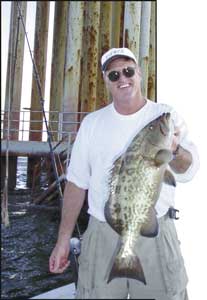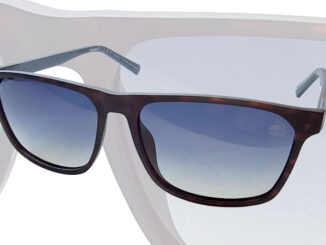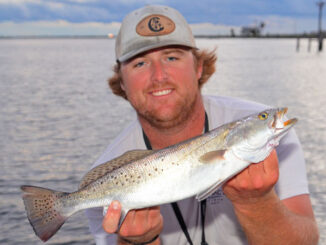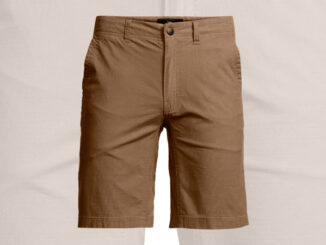
Snapper season’s over, but there’s a large variety of fish in the Ship Shoal blocks that eagerly take center stage this month.
With another successful recreational red snapper season under his belt, Capt. Tommy Pellegrin quickly adapts his methods to concentrate on the mixed bag of other species that swarm the platforms and reefs near his home port of Cocodrie. “Sometimes the phone calls slow down right after the red snapper season closes,” says Pellegrin.
Anglers are often left in a quandary as to what species to target during the blustery months of November and December. According to Pellegrin, this is a mistake since the countless maze of oil rigs and wellheads that dot the area offer plenty of fish and numerous options for anglers targeting them.
“My recommendation would be to head out of Whiskey Pass toward Ship Shoal,” Pellegrin suggests.
This vast field of oil and gas facilities stretching many miles to the West of Cocodrie offers all sorts of opportunities to anglers, even those with smaller boats.
“You really don’t have to run that far to find plenty of fish. We actually do most of our fall and winter fishing in 40 to 100 feet of water,” Pellegrin said.
“Starting the day after snapper season closes, my son Eric and I target tuna, amberjack, mangrove snapper, grouper, triggerfish and cobia.”
Successful anglers know that proper planning is the key to success. Before leaving the dock, Pellegrin has a route mapped out with stops in various depths of water.
Pellegrin suggests starting in Ship Shoal blocks 208, 209, 214 and 215, which are all located about 33 miles out of Whiskey Pass.
Mangrove Mania
The Pellegrins usually begin their fall trips by targeting mangrove snapper with live croakers or live shrimp, when available. Using either a 6/0 Mustad 39952BL circle hook or a 4/0 94140BLN live bait hook, they free line the croakers in the current toward the rig legs.
Another unique way to present a live bait to a school of swarming mangroves is similar to a yo-yo or slingshot method. Have a buddy gather the line in large loops in one hand. Have him use the other to hold the leader and the croaker and gently swing the bait around, gathering momentum, and let it go. The croaker will plop onto the surface carrying with it plenty of slack line. In most cases, the strike is instantaneous, so the angler needs to be ready to hit the fish as soon as it engulfs the stunned croaker.
“The mangrove fishing has been really, really good this year, and we have usually had no problem filling our limits,” Tommy Pellegrin said.
The Pellegrins’ choice of tackle includes a Challenger COSS70MH spinning rod with either a 750SSM Penn or SE 10000 Tica reel. Reels are spooled with 60-pound Mustad Ultra Braid, and 2 to 3 feet of 60-pound fluorocarbon top shot completes the terminal end. Flurocarbon is a necessity for leader-shy quarry such as mangrove snapper.
Tasty Triggers
Other less-sought-after species such as grey triggerfish also help fill the cooler in the fall. These tasty fish, which sport thick lips and a full set of pearly white teeth, are plentiful around the rigs.
“We usually target them in relatively shallow water (20 to 30 feet), using a J-hook and a small piece of cut bait or squid. If we can’t get that, we’ll use a small piece of pogie with the skin on,” said Pellegrin.
When targeting triggerfish with a J-hook, an angler must set the hook hard once he feels a bite, unlike when using a circle hook. These bait stealers have tough, small mouths, and can be tough to catch. But they are well worth the effort as they make great table fare.
Due to their tough, grey skin, triggers are considered to be a pain to clean, but Eric Pellegrin has developed a foolproof method.
“To clean triggers, start from the tail and cut along the back bone to the ribcage, and circle the ribs to the head,” he said. “This will leave the fillet connected to the head, and you just need to cut it off. Then fillet the skin off of the meat, and trim the center line bones out. These are easy to find by passing your finger over the slab of meat.”
Count on Cobia
Late-season cobia can be found roaming from the beach line out to about 100 feet of water. These inquisitive brown fish, which are sometimes mistaken for sharks, will come up to take a look as a boat approaches. Keep a keen eye behind the motor, and never approach a rig without a rod in hand.
If no fish are present on the surface, try sending a bait down to the bottom. Even if you hook a different species, such as a snapper or trigger, cobia will often follow the hooked fish to the surface, enabling the angler to toss a live bait on its nose.
In addition to live baits such as croaker, pinfish, small hardtails or even hardhead catfish with their dorsal spine clipped, cobia will invariably attack a plastic if properly presented.
Pellegrin prefers to use a 1- to 2-ounce lead jig with a variety of brightly colored tails such as the Old Bayside Monster Mino in candy corn or pink, and employs a teasing method.
“Toss the jig in front of the fish and reel. When the cobia comes to smell it jerk it away just a little,” said Pellegrin.
Repeat the process until the cobia takes the jig, and then set the hook hard.
Be patient and let the fish run, as these brutes need to be worn out before bringing boatside for gaffing. A ‘green’ cobia can cause injury and create havoc on the deck of a boat if not properly handled. When targeting cobia, it is crucial to have a gaff or large net, in addition to some sort of club to subdue the thrashing fish once boated. Cobia have a row of spines along their backs that are capable of inflicting a nasty, painful wound.
Deep for Grouper, AJs
For those who have access to a larger boat and can travel longer distances on a day trip, the deeper wrecks, reefs and rigs hold some fantastic grouper and amberjack opportunities. These hard-fighting monsters generally prefer depths of 100 to 400 feet, and can be found all along the edges of the canyons.
Fishing for either grouper or amberjack requires somewhat stouter tackle, including short broomstick rods with unlimited ratings, 50W reels spooled with heavy mono or 250-pound braided line and 200- to 300-pound leaders. Drags are usually set at 40-50 pounds, or in extreme cases, cranked down in an effort to break the fish off the bottom or away from the rig. Gaining and maintaining that first 5 or 10 feet of line is critical in successfully landing these brutes.
One good way of locating grouper is to look for rock piles or wrecks. Anytime you are running offshore, keep an eye on the bottom finder. Anglers may sometimes see as little as a 2-foot rise or, other times, as much as 20 to 30 feet. These areas hold grouper, snapper and some odd ball species.
Although Pellegrin prefers to target grouper on rock piles, he often finds them holding tight against the rig legs.
“Grouper are a little more difficult around a rig, because you have to battle them all the way to the surface, keeping them out of the rig,” he said. “On a rock pile, you only have to break them 5 or so feet off the bottom to win the battle.
“Last summer, Eric found one little spot that had only a 2-foot rise. Although we didn’t find grouper that day, we finished off our snapper and amberjack in that small spot.”
The most effective way to target grouper is by using live bait and enough weight to get it to the bottom. To alleviate strikes from smaller fish, many who target grouper insist on baits of 6 inches or larger, which can only be swallowed by the big-mouthed fish.
Pellegrin targets amberjack with large hardtails impaled through the back with an 8/0 Mustad 39950BL Ultra Point circle hook. He cautions anglers, if they prefer to use any other hook, to beef up and use an 11/0 to ensure solid hookups.
The key to a successful amberjack trip, says Pellegrin, is location, location, location.
“You must be in the right place and in at least 150 to 200 feet of water,” he said. “Use your bottom finder, and ease around the rig to locate the amberjack, which prefer the upper half of the water column.”
Pellegrin suggests that anglers start out with a 30-second count to get the bait down to the depth that the fish are holding. Subsequent drops can be shorter or longer depending on success of hook up.
“The No. 1 rule in amberjack fishing is when the fish takes the bait do not pull back to set the hook,” says Pellegrin. “Let the rod bend and load, and then reel the fish tight using short pumps to keep the amberjack out of the rig. If necessary use the boat to pull the fish away from the rig, but not so far away as to break up the school.”
Tuna Frenzy
Falling temperatures signal the much-anticipated return of acres of blackfin tuna as well as hard-fighting open-water yelllowfin tuna. Both can be targeted in a variety of ways.
Many times, boats will pull up behind a shrimp trawler and toss out a handful of chum to see if tuna are present. Generally, bonito and eventually tuna can be seen speeding through the slicks, and can be led out from under the shrimp boat by deploying a steady stream of chum.
“Once you see tuna in the slick, place a piece of chum on a Mustad 39950BL 6/0 or 7/0 circle hook, and gently toss it in front of a tuna,” said Pellegrin.
The good news for anglers is that in most instances the tuna behind the boats are not finicky eaters, and will hit with a vengeance — just make certain to stay clear of the cables and trawl or you will quickly wear out your welcome with the crew.
One of the most thrilling ways to target tuna is by using oversized spinning rods and stout braided line to cast poppers to fish busting on the surface. This method has proven to be one of the most effective ways to locate tuna around the shrimp boats, especially if the nets are still being worked.
Relatively new on the market and highly effective is the Angry Popper by Frenzy Big Game Tackle. The heavy duty construction of the 8-inch popper with oversized prismatic eyes enables it to be fished right out of the package, avoiding the frustration and added expense of changing out hooks or split rings.
“As I captain, what I like about it is that it comes rigged and ready to fish, so if I lose one, I can quickly tie on another and get back to fishing,” says Pellegrin.
The technique of fishing around shrimp boats requires coordination to avoid being swept into the nets. Carefully maneuver ahead of the shrimp boat and cast the Angry Popper in front of the boat, and work it back quickly under the booms. The popper can be worked near the surface or allowed to sink slowly to trigger strikes from fish holding beneath the bow. Just be certain to maintain communication with the trawler to avoid an accident.
Many times in the fall, yellowfin tuna will be found in massive schools in open water. When approaching a school of wary tuna, do so slowly from the upwind side, maintaining enough distance to avoid spooking the fish. Go to neutral or even cut the engines and slowly drift toward the school so as not to cause them to sound.
Using the heavy 4-ounce weight of the Angry Popper to load the rod, make a long cast. Hold the rod tip high, and reel fast to create a scurrying motion across the surface to mimic a fleeing baitfish. Keep tension on the line at all times to ensure solid hookups when tuna crash the popper.
For evening trips, try the Frenzy Ballistic Flying Fish, with glow-in-the-dark technology, which draws vicious strikes from tuna around the rigs.
Tune up your tackle, and head out to sample Ship Shoal’s non-stop fall action. Keep in mind as temperatures drop and the Gulf stays warm, heavy fog can develop quickly, leaving boaters in dire straits.
Capts. Tommy and Eric Pellegrin can be reached at (985) 851-3304.


